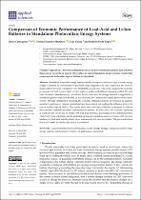Por favor, use este identificador para citar o enlazar este ítem:
https://repositorio.usj.es/handle/123456789/614
| Título : | Comparison of Economic Performance of Lead-Acid and Li-Ion Batteries in Standalone Photovoltaic Energy Systems |
| Autor: | Carroquino, Javier


Escriche-Martínez, Cristina 

Valiño, Luis 

Dufo-López, Rodolfo 


|
| Palabras clave : | Li-ion batteries; Lead-acid batteries; Electric energy storage; Standalone photovoltaic energy systems; Off-grid storage; Microgrids |
| Fecha de publicación: | 16-abr-2021 |
| Editorial : | MDPI |
| Citación : | Carroquino, J.; Escriche-Martínez, C.; Valiño, L.; Dufo-López, R. Comparison of Economic Performance of Lead-Acid and Li-Ion Batteries in Standalone Photovoltaic Energy Systems. Appl. Sci. 2021, 11, 3587. https:// doi.org/10.3390/app11083587 |
| Resumen : | Standalone renewable energy systems usually incorporate batteries to get a steady energy supply. Currently, Li-ion batteries are gradually displacing lead-acid ones. In practice, the choice is made without previous comparison of its profitability in each case. This work compares the economic performance of both types of battery, in five real case studies with different demand profiles. For each case, two sets of simulations are carried out. In one of the sets, the energy demand is supplied by a standalone photovoltaic system and, in the other one, by a standalone hybrid photovoltaic-diesel system. Through optimization processes, the economic optimum solutions are obtained. In addition, sensitivity analyses on various parameters have been carried out, seeking the influence in favor of one or another type of battery. The results show that if the type of battery is changed, to achieve the economic optimum the entire system must be resized. In some cases, the economic optimum is reached with Li-ion and in others with lead-acid batteries, depending on the demand profiles. Thus, both types of batteries can be profitable options in standalone energy systems, with a greater tendency to lead-acid in fully photovoltaic systems and to Li-ion in hybrids. The price reductions that would make Li-ion the only choice is quantified. |
| URI : | https://repositorio.usj.es/handle/123456789/614 |
| ISSN : | 2076-3417 |
| Aparece en las colecciones: | Artículos de revistas |
Ficheros en este ítem:
| Fichero | Descripción | Tamaño | Formato | |
|---|---|---|---|---|
| Comparison of Economic Performance of Lead-Acid and Li-Ion Batteries in Standalone Photovoltaic Energy Systems.pdf | 3,78 MB | Adobe PDF |  Visualizar/Abrir |
Este ítem está sujeto a una licencia Creative Commons Licencia Creative Commons

